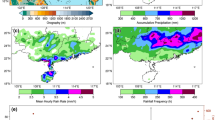Abstract
On 24–25 July 2010, a Plateau Vortex system forming to the north of Tibetan Plateau dramatically changed its moving direction to westward after several days of eastward movement. Observational analysis showed that, during its westward movement, a low-level southeasterly or easterly wind developed over the Sichuan basin. The large-scale forcing became favorable for the convection development. The low-level warm advection was more favorable for convection development than the differential vorticity advection. The daytime scattered convections were organized into a mesoscale convective system (MCS) after sunset, which produced extremely heavy rainfall in the eastern slope of the Western Sichuan Plateau. The observational evidences and numerical simulations have indicated that the topographically induced dynamical lifting over the lower topography and the convergence caused by the topographical blocking provided strong support for the convection initiation. The cold outflows caused by surface evaporative cooling of rain steered the MCS to move away from its original place, while the convergence between the cold outflows and the environmental southeasterly flow apparently helped the maintenance of the MCS. The intensification of the low-level flow, which was associated with the diurnal variation of radiative forcing, contributed to the organization and intensification of the MCS. The results of sensitivity experiments further confirmed the impact of topography in the convection initiation, and the influences of cold outflows caused by surface evaporative cooling of rain on the movement and maintenance of the MCS. The effects of the diurnal variation of radiative forcing on the organization of the MCS are also well represented in the model results.





















Similar content being viewed by others
References
Chang C, Lan Y, Chen G (2000) A numerical simulation of vortex development during the 1992 East Asian summer monsoon onset using the Navy’s regional model. Mon Wea Rev 128:1604–1631
Chen Z, Min W, Miao Q, He G (2004) A case study on coupling interaction between Plateau and Southwest Vortexes. Plateau Meteorol (in Chinese) 23(1):75–80
Chen H, Yuan W, Li J, Yu R (2012) A possible cause for different diurnal variations of warm season rainfall as shown in station observations and TRMM 3B42 data over the southeastern Tibetan Plateau. Adv Atmos Sci 29(1):193–200
Dell’Osso L, Chen S (1986) Numerical experiments on the genesis of vortices over the Qinghai-Xizang Plateau. Tellus 38:235–250
Fu S, Zhao S, Sun J, Li W (2010) One kind of vortex causing heavy rainfall during pre-rainy season in South China. Chin J Atmos Sci (in Chinese) 34(2):235–252
Fu S, Sun J, Zhao S, Li W (2011a) The energy budget of a southwest vortex with heavy rainfall over South China. Adv Atmos Sci 28(3):709–724
Fu S, Sun J, Zhao S, Li B (2011b) A study of the impacts of the eastward propagation of convective cloud systems over the Tibetan Plateau on the rainfall of the Yangtze Huai River basin. Act Meteor Sin (in Chinese) 69(4):581–600
Grell GA, Devenyi D (2002) A generalized approach to parameterizing convection combining ensemble and data assimilation techniques. Geophys Res Lett 29:1693. doi:10.1029/2002GL015311
Gu Q, Shuai R, Xu H (2010) Comparison analysis of the circulation characteristics of Plateau Vortex moving out of and not out of the Plateau. Meteor Mon (in Chinese) 36(4):7–17
He G, Gao W, Tu N (2009) The dynamic diagnosis on eastwards moving characteristics and developing mechanism of two Tibetan Plateau Vortex processes. Act Meteor Sin (in Chinese) 67(4):599–612
Hong S, Pan H (1996) Nonlocal boundary layer vertical diffusion in a medium-range forecast model. Mon Wea Rev 124:2322–2339
Hu L, Li Y, Fu R, He J (2008) The relationship between mobile mesoscale convective systems over Tibetan Plateau and the rainfall over eastern China in summer. Plateau Meteorol (in Chinese) 27(2):301–309
Huang H, Wang C, Chen G, Carbone RE (2010) The role of diurnal solenoidal circulation on propagating rainfall episodes near the eastern Tibetan Plateau. Mon Wea Rev 138:2975–2989
Jiang Y, Zhang W, Zhou Z, Zhang Z (2004) Analyses and numerical simulations of southwest vortex rainstorm processes in July 2000. Plateau Meteorol (in Chinese) 23(1):55–61
Kuo Y, Cheng L, Bao J (1988) Numerical simulation of the 1981 Sichuan flood. Part I: evolution of a mesoscale southwest vortex. Mon Wea Rev 116:2481–2504
Li Y (1995) The relationship between PBL’s wind field over Chengdu and hard rain over Sichuan basin during summer half year. Plateau Meteorol (in Chinese) 14(2):232–236
Li Y (1996) The PBL dynamic diagnosis of heavy rain over the upper reaches of the Changjiang River. Chin J Atmos Sci (in Chinese) 20(1):73–78
Li Y (2000) The PBL wind field at the eastern edge of the Tibetan Plateau and its relations with heavy rain-flood of the Changjiang River in 1998. Chinese J Atmos Sci (in Chinese) 24(5):641–648
Li Y, Peng H, Zhang B (1997) A verification of weather significance of PBL wind field evolution at Chengdu. Plateau Meteorol (in Chinese) 16(3):331–336
Li L, Zhang R, Wen M (2011) Diagnostic analysis of the evolution mechanism for a vortex over the Tibetan Plateau in June 2008. Adv Atmos Sci 28(4):797–808
Liu L, Feng J, Chu R et al (2002) The diurnal variation of precipitation in monsoon season in the Tibetan Plateau. Adv Atmos Sci 19(2):365–378
Luo H, Yanai M (1983) The large-scale circulation and heat sources over the Tibetan Plateau and the surrounding areas during the early summer of 1979. Part I: precipitation and kinematic analysis. Mon Wea Rev 111:922–944
Luo S, He M, Liu X (1994) Study on the vortex of the Qinghai-Xizang Plateau in summer. Sci China Ser B 37(5):601–612
Ma KY, Bosart LF (1987) A synoptic overview of a heavy rain event in southern China. Wea Forecast 2:89–102
Peng G, Chai F, Zeng Q, Yu R (1997) Research on “Ya-An-Tian-Lou” Part I: weather analysis. Chin J Atmos Sci (in Chinese) 18(4):466–475
Qiao Q (1987) The environment analysis on 500 hPa vortexes moving eastward out of Tibet Plateau in summer. Plateau Meteorol (in Chinese) 6(1):45–55
Shen R, Reiter ER, Bresch JF (1986) Some aspects of the effects of sensible heating on the development of summer weather systems over the Tibetan Plateau. J Atmos Sci 43:2241–2260
Smith RB (1979) The influence of mountains on the atmosphere. Advances in Geophysics, Vol. 21. Academic Press, New York, pp 87–230
Tao S, Ding Y (1981) Observational evidence of the influence of the Qinghai-Xizang (Tibet) plateau on the occurrence of heavy rain and severe convective storms in China. Bull Amer Meteor Soc 62:23–30
Thompson G, Field PR, Rasmussen RM, Hall WD (2008) Explicit forecasts of winter precipitation using an improved bulk microphysics scheme. Part II: implementation of a new snow parameterization. Mon Wea Rev 136:5095–5115
Tu N, He G (2010) Case analysis on two vortexes induced by Tibetan Plateau shear line. Plateau Meteorol (in Chinese) 19(1):90–98
Wang B (1987) The development mechanism for Tibetan Plateau warm vortices. J Atmos Sci 44:2978–2994
Wang B, Orlanski I (1987) Study of a heavy rain vortex formed over the eastern flank of the Tibetan Plateau. Mon Wea Rev 115:1370–1393
Wang W, Kuo Y, Warner TT (1993) A diabatically driven mesoscale vortex in the lee of the Tibetan Plateau. Mon Wea Rev 121:2542–2561
Wang C, Chen G, Carbone RE (2005) Variability of warm-season cloud episodes over East Asia based on GMS infrared brightness temperature observations. Mon Wea Rev 133:1478–1500
Wang X, Li Y, Yu S, Jiang X (2009) Statistical study on the plateau low vortex activities. Plateau Meteorol (in Chinese) 28(1):64–71
Wei T, Xue J (1996) The mesoscale structure characteristics of southwest vortex over Jiang-Huai River areas. Plateau Meteorol (in Chinese) 15(4):456–463
Xia J, Wu T, Laurent L (2013) The quasi-stationary feature of nocturnal precipitation in the Sichuan basin and the role of the Tibetan Plateau. Clim Dyn 41(3–4):977–994
Xu W, Zipser ED (2011) Diurnal variations of precipitation, deep convection, and lightning over and east of the eastern Tibetan Plateau. J Clim 24:448–465
Yanai M, Li C (1994) Mechanism of heating and the boundary layer over the Tibetan Plateau. Mon Wea Rev 122:305–323
Yasunari T, Miwa T (2006) Convective cloud systems over the Tibetan Plateau and their impact on meso-scale disturbances in the Meiyu/Baiu frontal zone—a case study in 1998. J Meteor Soc Japan 84:783–803
Ye D, Gao Y (1979) The meteorology of the Qinghai-Xizang Plateau. Scientific Press (in Chinese), Beijing 278 pp
Yu S (2002) Water vapor imagery of vortex moving process over Qinghai-Xizang Plateau. Plateau Meteorol (in Chinese) 21(2):199–204
Yu S, He G (2001) Numerical experiment of influence of water vapor in the middle and upper troposphere on the formation of vortex over the Tibetan Plateau. J Nanjing Inst Meteor 24(4):553–559
Yu S, He G, Teng J (1997) The numerical experiments of influence of shear line over Qinhai-Xizang Plateau on a sharp heavy rain in west Sichuan basin. Plateau Meteorol (in Chinese) 16(3):306–310
Yu R, Zhou T, Xiong A, Zhu Y, Li J (2007a) Diurnal variations of summer precipitation over contiguous China. Geophys Res Lett 34:L01704. doi:10.1029/2006GL028129
Yu S, Gao W, Gu Q (2007b) The middle-upper circulation analysis of the Plateau Vortex moving out of the Plateau and influencing flood in east China in recent years. Plateau Meteorol (in Chinese) 26(3):466–475
Zhang S, Tao S, Zhang Q, Zhang X (2001) Meteorological and hydrological characteristics of severe flooding in China during the summer of 1998. J Appl Meteor Sci (in Chinese) 12(4):442–457
Zhao S, Fu S (2007) An analysis on the Southwest Vortex and its environment fields during heavy rainfall in eastern Sichuan province and Chongqing in September 2004. Chin J Atmos Sci (in Chinese) 31(6):1059–1075
Zhao Y, Wang Y (2010) A case study on Plateau Vortex inducing southwest vortex and producing extremely heavy rain. Plateau Meteorol (in Chinese) 29(4):819–831
Zhao Y, Xu X, Cui C (2012) A study of convective rainstorms along the east slope of Western Sichuan Plateau. Clim Environ Res (in Chinese) 17(5):607–616
Zheng Q, Wang B, Song Q (1997) Numerical study on the leeward side orographic effects of Qinghai-Xizang Plateau on a Southwest Vortex process. Plateau Meteorol (in Chinese) 16(3):225–234
Zhou T, Yu R, Chen H et al (2008) Summer precipitation frequency, intensity, and diurnal cycle over China: a comparison of satellite data with rain gauge observations. J Clim 21:3997–4010
Acknowledgments
This study is sponsored by the project of the Ministry of Science and Technology of the People’s Republic of China under grant No. GYHY201206003, the science foundation of State Key Laboratory of Severe Weather under grant No. 2014LASW-A05, and by the National Natural Science Foundation of China under grant Nos. 41075038, 41405106, and 40975025. The author appreciates the Institute of Plateau Meteorology of CMA for providing the 6-hourly intensive observed radio-sounding data at Hongyuan, Yaan and Wenjiang.
Author information
Authors and Affiliations
Corresponding author
Additional information
Responsible Editor: M. Kaplan.
Rights and permissions
About this article
Cite this article
Zhao, Y. A study on the heavy-rain-producing mesoscale convective system associated with diurnal variation of radiation and topography in the eastern slope of the western Sichuan plateau. Meteorol Atmos Phys 127, 123–146 (2015). https://doi.org/10.1007/s00703-014-0356-y
Received:
Accepted:
Published:
Issue Date:
DOI: https://doi.org/10.1007/s00703-014-0356-y




